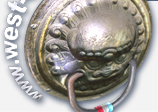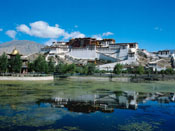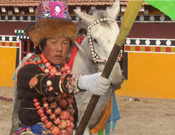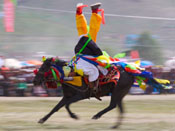| Collectors
Council Trip to Tibet
Amdo & Kham Grasslands Kumbum Festival
Train Trip through Central Tibet
Day 1. : Arrive at Shanghai.
Overnight 4 star hotel.
Day 2. :Tour Shanghai
Visit Shanghai Old Town, famous for its shops. Tour 5 acre Yu Garden,
an island of tranquility amid the hustle and bustle of the city,
it contains over 30 pavilions and lotus ponds, bridges and winding
paths which are characteristic of the architectural style of the
Ming dynasty. It was a private garden with a history of 400 years.
Outside the Yu Garden there is very interesting market, the Yuyuan
Bazaar. Walk the riverside waterfront area known as the Bund. After
lunch we visit the I.M. Pei Museum. Overnight Shanghai at 4 star
hotel. B. L.D.
Day 3. : Shanghai to
Lanzhou
In the morning, we fly to Lanzhou, the capital city of Gansu Province.
It is an important industry city in Northwest China. Alt: 1600 m.(5248
ft.) and was a vital communication line on the old Silk Road. If
time allows, visit the Provincial Museum. Overnight at the Lanzhou
Sunshine Hotel***. B.
Day 4. : Lanzhou to Labrang
Drive 290 km (7 hours) to Labrang (Alt: 2900m) seeing the Chinese
Muslim Hui people with many mosques along the roadsides. Lunch is
in Linxia Hui Autonomous City, which is known as the “Small
Hong Kong” by local people. We’ll visit one street specializing
in Tibetan antiques. In the last third of today’s journey
the landscape becomes more beautiful and you will start to see white
chortans by the roadside. Now you will feel you are really in Tibet.
Overnight at the Overseas Hotel, strategically located on the main
street of Labrang. This hotel has internet access and a restaurant
where you can buy a burger and rub elbows with travelers from all
over the world. B.
Day 5. : Labrang
Morning visit to Labrang monastery-built in 1709, it now has 1000
monks. It is one of the six most important Gelukpa (Yellow Sect)
monasteries in all of Tibet. We will see many Tibetan nomads here
who have come on pilgrimage. They stop to buy textiles for their
clothing and jewelry in the numerous Tibetan shops. Overnight in
Labrang at the Overseas Hotel. B.
Day 6. : Labrang
A full day for shopping in Labrang, all within walking distance
of our hotel. It is interesting not only to see the variety of antiques
and textiles from this area but also to peek in the stores that
provide the nomads with their household needs. For those not interested
in shopping, take a drive outside of town on the beautiful grasslands
to visit some Tibetan nomadic families and at the same time enjoy
the landscape. Overnight in Labrang at Overseas Hotel. B.
Day 7. : Labrang / Tongren
(Tibetan name:Repkong)
Morning drive of 130 km.(about 4 hours) to Repkong Alt: 2400 m.
(7872 ft.) Pass through the beautiful Red Mountain Valley seeing
grasslands, forests and agricultural land. Afternoon visit to the
famous Tibetan art school, Sengeshong Magotsang which was founded
during the 15th century. Repkong, by the 16th century had became
the center of Tibetan art in Amdo. All monks here have been well
trained in the arts of painting and sculpting. They are invited
by people from all over Tibet to create works of art for monasteries
and private houses. We will visit some of monks’ houses. Upon
arrival, we check in the best local hotel, Overnight in Repkong
at Hua Nan Hotel or Post Hotel. B.
Day 8. : Tongren / Maqen
(aka Machen).
It is an interesting drive to Machen, the Tibetan Golok capital.
The Goloks in the past were the most feared Tibetans because they
made their living from plundering the caravans that passed through
Xining and on to Lhasa. We encounter a great variety of landscapes;
from a sea of sand with huge dunes and a heavily eroded landscape
of strange shapes, to pastureland. This is where nomads can be seen
herding their flocks of sheep, living for the summer in black yak
hair tents. We will stop at a monastery en route and admire the
huge lhatses of colored flags and spears. These are refurbished
every year by the men of the family in honor of the Mountain Gods.
The altitude increases to 3800 m. (12,464 ft.) here but we shall
be acclimatized as we have driven higher slowly. Overnight in Machen
at Snow Mountain Hotel or another better hotel with facilities.
B.
Day 9. : Machen / Madoi
(aka Mato)
If the weather is fine we should see Amnye Machen, once thought
to be higher than Mount Everest. In the 1960's the height was fixed
at 6282 m.(20,604 ft.). Amnye Machen is the sacred home of the protector
deity Machen Pomra, revered by Bonpo and Buddhists alike. It is
a day of wonderful “skyscapes” and rolling pastureland
grazed upon by sheep and yaks. We’ll picnic on the open plateau
among the wild flowers. Mato, where we stay, standing at approximately
4200 meters (13,776 ft.) is one of the highest points on this journey.
It is an outback frontier town and is an administrative centre for
the Golok prefecture. This is the most testing hotel. There are
no private facilities but the rooms are clean and warm and the food
is fine. It can be very cold on the windswept plateau. White clouds
scud across the blue sky, sometimes quickly changing to grey. This
can mean the occasional snow storm, which passes as quickly as it
came. Overnight in Mato at the best facilities available.
Day 10. : Mato to Yushu
(aka Jyekundo)
Drive 360 km. to Jyekundo: alt: 3700 m. (12,136 ft.) Today’s
driving is exciting; we pass the first bridge of the Yellow River,
and then the famous mountain pass Bayankala at elevation 5080 m.
(16,662 ft.) where we will throw Prayer papers into the wind and
shout “Lha Jia Lo.” in thanks for a safe journey across
this high point. Passing the upper reaches of the Yangtze River,
these landscapes present an amazing picture. Under the blue sky
with white clouds you will see mountains decorated with pray flags,
beautiful grasslands embellished with flocks of yak and sheep, nomad’s
black and white tents and the colorfully dressed Golok and Khampa
people. Lunch is at a typical frontier town and we will probably
see nomadic girls wrapped in wool chubas wearing yellow amber pieces
on their long black hair, contrasting with blue turquoise. As we
approach Jyekundo the hills are a rich green and we note a number
of monasteries, perched high on the cliff face, painted in earth
colors. Jyekundo is the capital of the Yushu Tibetan Autonomous
Prefecture. This region is known for the monasteries belonging to
Sakyapa and Kagyu sects.. Overnight Yushu Hotel*** with facilities
in the rooms and hot water for shower. B.
Day 11. : Jyekundo
The local people honor Jyekundo by calling it “Small Lhasa”.
More than 90% of the population here are Tibetan Khampa, one of
the four main Tibetan tribes. They are the strong and wild but honest
formerly fierce warriors of Tibet. Many Sakyapa monasteries are
concentrated here with different construction style. We visit an
important Sakyapa monastery Jyekundo Dondrublin, built in 1398,
which at one time had more than 1000 monks. The monastery was home
to many Buddhist masters and scholars who made great achievements
in Tibetan religion, medicine, history and art. One of the Rinpoches
(teachers), Gyanak, choreographed more than 100 kinds of dances.
Jyekundo became the hometown of Tibetan dancing and singing. Later
we will visit another old Sakya monastery Saiba Gonpa. It was founded
in 1269. Overnight at the Yushu Hotel in Jyekundo. B.
Day 12. : Jyekundo
Drive about 20 km to the Lerba Mani Valley. Here there are countless
Mani stones which have been left in the very clean stream water.
After a local person’s death, the family seeks a Living Buddha’s
advice about a ceremony. They are told to place a certain number
of Mani stones into this small river. The swift water runs over
the rocks inscribed with the deceased’s name and this helps
to cleanse the dead person’s soul so they can be reincarnated
for the next life as quickly as possible. The river’s melodic
sound also helps the dead to be reincarnated to a new life. You
can also see many very old rock paintings on each side of cliffs
in this small valley. Some of them were done during the 7th century
when the Chinese Princess Wencheng, future wife of Tibetan king
Songten Gampo, passed through the valley. Overnight at the Yushu
Hotel in Jyekundo. B
Day 13. : Yushu/Chabcha
We drive 470 km.on another road to Chabcha. It is a fascinating
journey across a great variety of landscapes. We pass a sea of sand
with huge dunes and a surprising eroded landscape of strange shapes.
We drive through a large, flat desert basin where no any rain falls
for a long periods. Overnight in Chabcha at the best local hotel.
B.
Day 14. : Chabcha / Kokonor
/ Xining
We drive for 2 hours to Kokonor, the biggest holy lake of Tibet
and the largest salt lake in China. It covers an area of 4581 square
km. (2,844 sq.m.). About three thousands years ago, Mongolian and
Tibetan nomadic people believed that all of the holy lakes and the
holy mountains contained unique treasures or minerals. Those minerals
give out a kind of magnetism or spirit to a few special sensitive
Masters, like Shamans or Living Buddhas. The Masters then teach
people how to respect and protect nature in order to receive the
good luck waves from those holy mountains and lakes. The beneficial
waves emitted can help one to have a good fate in life. In May of
1578, King of the Mongols, Altan Qan gave the title Dalai Lama 3
to Sonam Gyatso at the east shore of Lake Kokonor. This was the
start of the “Living Buddha” system of Gelukpa. After
sightseeing by this beautiful lake and lunch, we drive for about
another 2 ½ hrs. to Xining, the capital city of Qinghai Province.
It city is located on the edge of the Tibetan Plateau at 2200 m.
(7,216 ft.). Today it is a quite modern city. There is little left
of the old walled town that used to be the main trading station
between China and Tibet and the entrance to the Silk Road. The population
today is Chinese, Tibetan, Mongolian, Muslim and Tu. Time allowing,
we will stroll down to see the huge fruit and vegetable market.
This is the time to buy lush peaches grown in the Lanzhou area and
famous all over China. Overnight at the Qinghai Hotel **** in Xining.
B.
Day 15. : Kumbum Festival
Morning visit to Kumbum Monastery to see lama artists perform a
masked dance that happens only twice a year. The performance starts
at 1:00 PM and finishes at 4:00 PM. Kumbum ,only 30 km. away from
Xining, was founded in 1560 to commemorate the birthplace of Tsongkhapa,
the founder of the Yellow Sect. The monastery was built round a
tree that was the birthplace of Tsongkhapa. For a short time the
abbot of this spectacular monastery was the Dalai Lama’s brother.
The monastery has a great assembly where one can buy everything
needed for monastic life. It also has antiques and tourist trinkets
for visiting pilgrims. Perhaps one of the most interesting workshops
is where they make the great metal sculptures of the “Wheel
of Life” which are mounted on the temple roofs. Textile enthusiasts
will be delighted to find various embroidery materials and hopefully
some antique embroidery. One of the most interesting finds is the
embroidered plait decoration the Tu people wear. Overnight at the
Qinghai Hotel **** in Xining.
Day 16. : Kumbum -“Sunning
the Buddha”
Early morning return to Kumbum (35 km- a ½ hr. ride) to see
the procession which marks the beginning of the Sunning the Buddha
ceremony. A huge Tangkha (40m long 20m wide) is carried by the monks
to be displayed on a slope for the Commemoration Day of Enlightenment
of Buddha Sakyamuni. Meanwhile in front of the big Buddha painting,
monks and believers pray for good rain for the crops and the grasslands.
In the afternoon we view the Masked Dance of Hayagriva (Horse Headed
Protector King) performed by the monks only twice a year. Overnight
in Xining at the Qinghai Hotel. B.
Day 17. : Kumbum
Day in Kumbum to explore the numerous local shops. Leave Kumbum
5 p.m. for 7 p.m. train departure from Xining on shared 1st- Class
4-berth soft sleepers train compartments. Overnight in the train.
B.
Day 18. : Golmud –
Lhasa (1240km)
About 7:00 a.m. we arrive at the Golmud station. In between Golmud
and Lhasa the train stops briefly at 9 different viewing platforms
for photo opportunities. Enjoy the highland scenery along the Qinghai-Tibet
Railway, which is the longest railway running on the world’s
highest plateau. We’ll see the Gobi desert with its huge wild,
dry plantless iron-colored mountains. Then suddenly the scenery
changes to beautiful grasslands rimmed by snow-covered mountains
sprinkled with herds of yak and sheep grazing under the blue sky.
Clean rivers and lakes look like mirrors. Nestled on the lush tundra
are countless different tiny highland flowers. At this time, you
will feel your body is melted with great nature. Our guide reports
that when their Western clients see these fantastic landscapes,
they begin singing and dancing regardless of the high altitudes,
even though most of them are in their 60s, & 70s, and the oldest
one is a lady, 86 years old. The highest point will be Tanggula
mountain pass (elevation 5200m,) this is where the Yangtze River
originates. Arrival at 8:00 p.m. in Lhasa . Overnight in Lhasa at
the Lhasa Yak Hotel***,
Day 19. : Lhasa Tour
If Tibet is the "Roof of the World”, then its capital,
Lhasa, is certainly the "City of the Sun". It stands on
a plain at over 13,000 feet (3700 m.) above sea level, surrounded
by towering mountains. Lhasa is a town bathed in sunlight. This
morning we have a leisurely breakfast in the hotel restaurant which
offers a view of the Potola. After an acclimatization rest in the
hotel we visit the Jokhang, the monastery considered to be at the
center of Tibetan Buddhism. Innumerable pilgrims come for worship
everyday. The temple, built in 647, is the earliest wood-and-masonry
structure still existing in Tibet. We’ll have time to walk
surrounding Barkhor Street lined with shops mostly owned by the
Chinese and smaller outdoor stalls owned by Tibetans. Everything
to supply the pilgrim’s needs can be found here: otter skins,
brocaded fabric, prayer flags, jewelry of coral, turquoise and amber,
leather pouches and handmade felt boots. Overnight at the Lhasa
Yak Hotel in Lhasa. B.
Day 20. : Lhasa Tour
We drive about 8 km. (4.96 m.) west of central Lhasa to visit Drepung
monastery. Once the world's largest monastery, it housed about 10,000
monks. It was founded in 1416 and the second, third and fourth Dalai
Lama resided here. In the afternoon, we visit Norbulingka which
has served as the summer residence since the 7th Dalai Lama. Norbulingka
means the “Garden of Treasures”. Overnight at the LhasaYak
Hotel in Lhasa. B.
Day 21. : Lhasa Tour
In the morning, we visit the Potala Palace, which was constructed
in 637 by Songtsen Gampo, the first king of the united Tibet. It
later served as the winter residence of the Dalai Lamas. Then we
drive to Sera monastery. Built in 1419, it has always been an important
Buddhist seminary. As roses are planted everywhere in the monastery,
it is also called the “Court of Wild Roses". Today 200
lamas still live here. We may see the lamas doing “scripture
debating”. Overnight Yak Hotel. B.
Day 22. : From Lhasa
fly to Shanghai.
Transfer to Gongga Airport and depart for Shanghai. Overnight 4
star hotel in Shanghai. B.
Day 23. : Shanghai to
LAX
Transfer to International Airport to take flight back home.
Tour includes: international
airfare, domestic airfare, all domestic transport within the tour
inside China and Tibet, accommodations at 4 star international standard
deluxe hotels in Shanghai, Lanzhou and Xining, 3 star hotel in Lhasa
and the best local hotels with standard rooms in the Amdo and Kham
area, good Japanese Landcruisers with three guests sharing one car
in the Amdo area, native Tibetan/English speaking guide, all hotels,
all admission fees, all breakfasts. Tour does not include your visa
for China, tips, and airport exit taxes. Price based on 10 participants.
You must join the Collectors Council to travel. For more info contact
Janet Seward at (949)650-4778 or e-mail sewardjan@aol.com.
|





